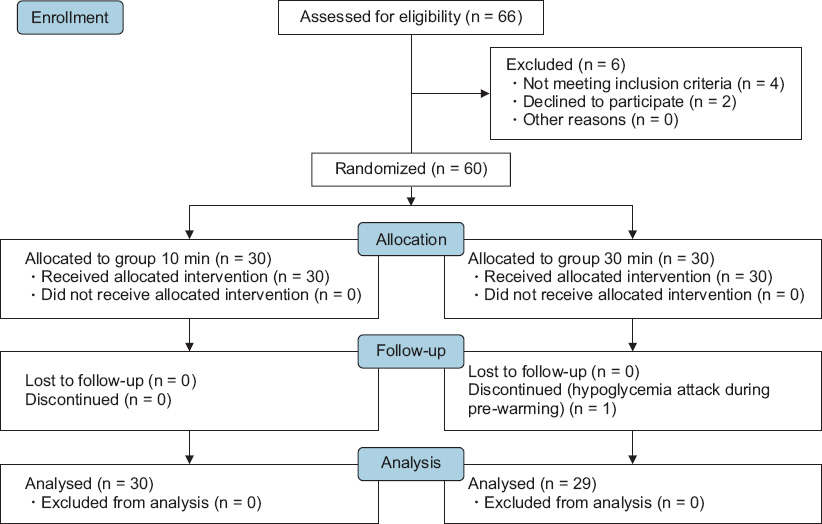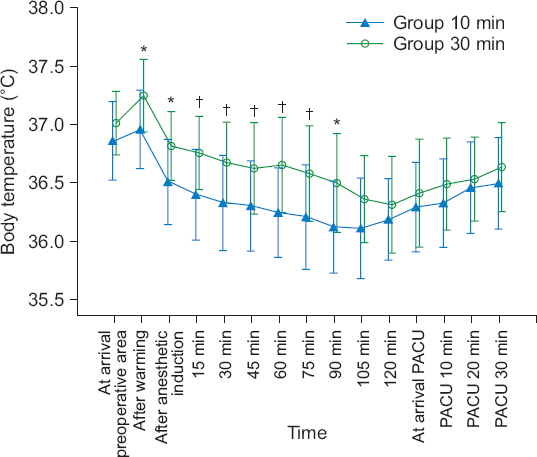Anesth Pain Med.
2018 Oct;13(4):447-453. 10.17085/apm.2018.13.4.447.
The effect of 10 minutes of prewarming for prevention of inadvertent perioperative hypothermia: comparison with 30 minutes of prewarming
- Affiliations
-
- 1Department of Anesthesiology and Pain Medicine, Soonchunhyang University Seoul Hospital, Soonchunhyang University College of Medicine, Seoul, Korea. syok2377@naver.com
- KMID: 2436007
- DOI: http://doi.org/10.17085/apm.2018.13.4.447
Abstract
- BACKGROUND
At least 30 minutes of pre-warming has been recommended for the prevention of redistribution hypothermia. However, it has been reported that less than 30 minutes of pre-warming is also effective. The aim of this study was to evaluate the ability of 10 minutes of pre-warming to prevent inadvertent perioperative hypothermia. Results were compared with 30 minutes of pre-warming.
METHODS
In this prospective randomized study, 59 patients scheduled for elective surgery less than 120 minutes under general anesthesia were divided into 2 groups: the first group was pre-warmed for 10 minutes (n = 30), the second group for 30 minutes (n = 29). The patients were pre-warmed for 10 or 30 minutes in the pre-anesthetic area using a forced-air warmer. When the patients' body temperatures decreased below 36℃, we warmed them with a forced-air warmer intraoperatively and postoperatively. Body temperatures were recorded during perioperative periods. Shivering and thermal comfort were evaluated in the pre-anesthetic area and post-anesthesia care unit.
RESULTS
The incidence of intraoperative and postoperative hypothermia were not significantly different (P > 0.05). However, the temperatures were higher in the 30 minute group from the post-warming time to 90 minutes after anesthetic induction (P < 0.05).
CONCLUSIONS
Ten minutes of pre-warming has the same effectiveness as 30 minutes of pre-warming for preventing inadvertent perioperative hypothermia. It is a preferable choice for the patients scheduled for surgery less than 120 minutes under general anesthesia.
MeSH Terms
Figure
Reference
-
REFERENCE
1. Young VL, Watson ME. Prevention of perioperative hypothermia in plastic surgery. Aesthet Surg J. 2006; 26:551–71. DOI: 10.1016/j.asj.2006.08.009. PMID: 19338943.2. Torossian A, Bräuer A, Höcker J, Bein B, Wulf H, Horn EP. Preventing inadvertent perioperative hypothermia. Dtsch Arztebl Int. 2015; 112:166–72. DOI: 10.3238/arztebl.2015.0166.3. Just B, Delva E, Camus Y, Lienhart A. Oxygen uptake during recovery following naloxone. Relationship with intraoperative heat loss. Anesthesiology. 1992; 76:60–4. DOI: 10.1097/00000542-199201000-00009. PMID: 1729937.4. Frank SM, Fleisher LA, Olson KF, Gorman RB, Higgins MS, Breslow MJ, et al. Multivariate determinants of early postoperative oxygen consumption in elderly patients. Effects of shivering, body temperature, and gender. Anesthesiology. 1995; 83:241–9. DOI: 10.1097/00000542-199508000-00002. PMID: 7631944.5. Frank SM, Fleisher LA, Breslow MJ, Higgins MS, Olson KF, Kelly S, et al. Perioperative maintenance of normothermia reduces the incidence of morbid cardiac events. A randomized clinical trial. JAMA. 1997; 277:1127–34. DOI: 10.1001/jama.1997.03540380041029. PMID: 9087467.6. Heier T, Caldwell JE, Sessler DI, Miller RD. Mild intraoperative hypothermia increases duration of action and spontaneous recovery of vecuronium blockade during nitrous oxide-isoflurane anesthesia in humans. Anesthesiology. 1991; 74:815–9. DOI: 10.1097/00000542-199105000-00003. PMID: 1673591.7. Lenhardt R, Marker E, Goll V, Tschernich H, Kurz A, Sessler DI, et al. Mild intraoperative hypothermia prolongs postanesthetic recovery. Anesthesiology. 1997; 87:1318–23. DOI: 10.1097/00000542-199712000-00009. PMID: 9416715.8. Rajagopalan S, Mascha E, Na J, Sessler DI. The effects of mild perioperative hypothermia on blood loss and transfusion requirement. Anesthesiology. 2008; 108:71–7. DOI: 10.1097/01.anes.0000296719.73450.52. PMID: 18156884.9. Kurz A, Sessler DI, Lenhardt R. Perioperative normothermia to reduce the incidence of surgical-wound infection and shorten hospitalization. Study of wound infection and temperature group. N Engl J Med. 1996; 334:1209–15. DOI: 10.1056/NEJM199605093341901. PMID: 8606715.10. Torossian A. TEMMP (Thermoregulation in Europe Monitoring and Managing Patient Temperature) Study Group. Survey on intraoperative temperature management in Europe. Eur J Anaesthesiol. 2007; 24:668–75. DOI: 10.1017/S0265021507000191. PMID: 17425815.11. Matsukawa T, Sessler DI, Sessler AM, Schroeder M, Ozaki M, Kurz A, et al. Heat flow and distribution during induction of general anesthesia. Anesthesiology. 1995; 82:662–73. DOI: 10.1097/00000542-199503000-00008. PMID: 7879935.12. Forbes SS, Eskicioglu C, Nathens AB, Fenech DS, Laflamme C, McLean RF, et al. Evidence-based guidelines for prevention of perioperative hypothermia. J Am Coll Surg. 2009; 209:492–503. DOI: 10.1016/j.jamcollsurg.2009.07.002. PMID: 19801323.13. Connelly L, Cramer E, DeMott Q, Piperno J, Coyne B, Winfield C, et al. The optimal time and method for surgical prewarming:a comprehensive review of the literature. J Perianesth Nurs. 2017; 32:199–209. DOI: 10.1016/j.jopan.2015.11.010. PMID: 28527547.14. Horn EP, Klar E, Höcker J, Bräuer A, Bein B, Wulf H, et al. Prevention of perioperative hypothermia :implementation of the S3 guideline. Chirurg. 2017; 88:422–8. DOI: 10.1007/s00104-016-0357-0. PMID: 28070632.15. Bräuer A, Waeschle RM, Heise D, Perl T, Hinz J, Quintel M, et al. Preoperative prewarming as a routine measure. First experiences. Anaesthesist. 2010; 59:842–50. DOI: 10.1007/s00101-010-1772-0. PMID: 20703440.16. Shin KS, Lee GY, Chun EH, Kim YJ, Kim WJ. Effect of short-term prewarming on body temperature in arthroscopic shoulder surgery. Anesth Pain Med. 2017; 12:388–93. DOI: 10.17085/apm.2017.12.4.388.17. Horn EP, Bein B, Böhm R, Steinfath M, Sahili N, Höcker J. The effect of short time periods of pre-operative warming in the prevention of peri-operative hypothermia. Anaesthesia. 2012; 67:612–7. DOI: 10.1111/j.1365-2044.2012.07073.x. PMID: 22376088.18. Gasim GI, Musa IR, Abdien MT, Adam I. Accuracy of tympanic temperature measurement using an infrared tympanic membrane thermometer. BMC Res Notes. 2013; 6:194. DOI: 10.1186/1756-0500-6-194. PMID: 23663659. PMCID: PMC3658932.19. Lee J, Lim H, Son KG, Ko S. Optimal nasopharyngeal temperature probe placement. Anesth Analg. 2014; 119:875–9. DOI: 10.1213/ANE.0000000000000361. PMID: 25025586.20. Sessler DI, Schroeder M, Merrifield B, Matsukawa T, Cheng C. Optimal duration and temperature of prewarming. Anesthesiology. 1995; 82:674–81. DOI: 10.1097/00000542-199503000-00009. PMID: 7879936.21. Just B, Trévien V, Delva E, Lienhart A. Prevention of intraoperative hypothermia by preoperative skin-surface warming. Anesthesiology. 1993; 79:214–8. DOI: 10.1097/00000542-199308000-00004. PMID: 8251019.22. Horn EP, Schroeder F, Gottschalk A, Sessler DI, Hiltmeyer N, Standl T, et al. Active warming during cesarean delivery. Anesth Analg. 2002; 94:409–14. DOI: 10.1097/00000539-200202000-00034. PMID: 11812709.23. Horn EP, Bein B, Broch O, Iden T, Böhm R, Latz SK, et al. Warming before and after epidural block before general anaesthesia for major abdominal surgery prevents perioperative hypothermia:a randomised controlled trial. Eur J Anaesthesiol. 2016; 33:334–40. DOI: 10.1097/EJA.0000000000000369. PMID: 26555870.24. Giesbrecht GG, Ducharme MB, McGuire JP. Comparison of forced-air patient warming systems for perioperative use. Anesthesiology. 1994; 80:671–9. DOI: 10.1097/00000542-199403000-00026. PMID: 8141463.
- Full Text Links
- Actions
-
Cited
- CITED
-
- Close
- Share
- Similar articles
-
- Effects of 10-min prewarming on core body temperature during gynecologic laparoscopic surgery under general anesthesia: a randomized controlled trial
- Prewarming for Prevention of Hypothermia in Older Patients Undergoing Hand Surgery Under Brachial Plexus Block
- Effect of short-term prewarming on body temperature in arthroscopic shoulder surgery
- Active Warming during Preanesthetic Period Reduces Hypothermia without Delay of Anesthesia in Cardiac Surgery
- The Effect of Preoperative Warming On Reducing Rectal Temperature Drop in Surgical Patients



